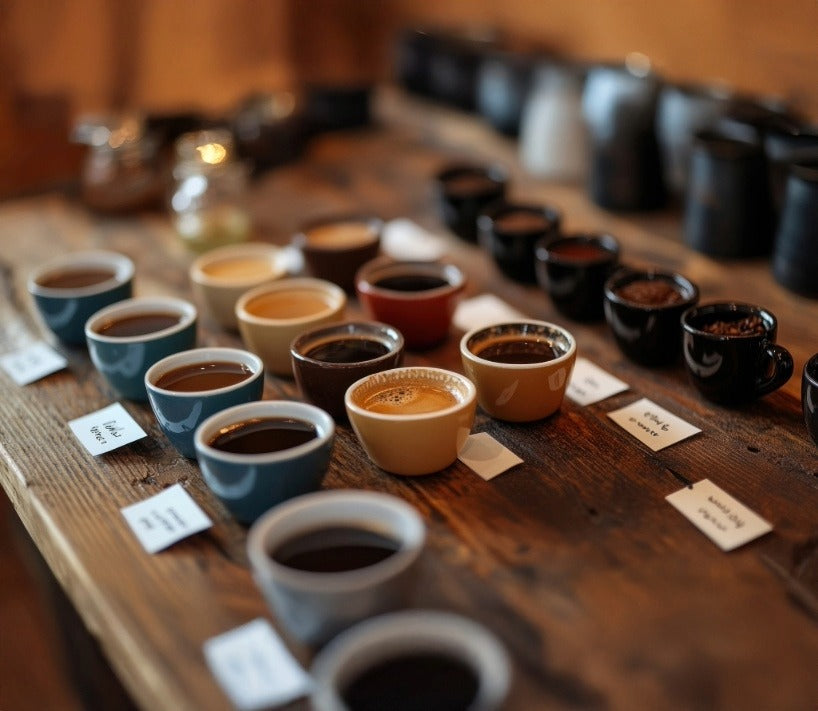Best coffee to buy online carbon free
May 07, 2025 4 min read
Hydrocarbon Latte? No Thanks!
Why I Stick to Air‑Roasted Beans (and You Should, Too)
“Wait…am I sipping lighter fluid?”
Picture me, hunched over my morning pour‑over like Gollum protecting the One Ring. I take that first glorious slurp…and a wild thought appears: What if a little bit of barbecue fuel just hit my taste buds? Turns out that’s not as crazy as it sounds. Studies have shown that roasting coffee over propane or natural gas can leave trace polycyclic aromatic hydrocarbons (PAHs)—a family of combustion by‑products you definitely don’t want in your cup. One paper found measurable PAH levels in dark‑roasted beans, with notorious bad actors like benzo[a]pyrene tagging along for the ride. (PubMedSpringerLink)
So if you’ve been patting yourself on the back for tracking down the best coffee online or hunting “specialty coffee near me,” you might still be unknowingly chugging microscopic leftovers from the roasting flame. Yuck.
The Science, the Slip‑Ups, and the Switch
1. What Exactly Are Hydrocarbons?
Hydrocarbons are molecules made of hydrogen and carbon—great for powering forklifts, less great for flavoring lattes. When propane or methane (natural gas) burns, most of it turns to CO₂ and water. But combustion is rarely perfect; tiny “unburned” fragments hitchhike on the hot exhaust and settle onto anything nearby—like coffee beans rotating in a drum roaster. Researchers have cataloged more than a dozen PAHs in roasted coffee, with concentrations climbing as roast levels darken PMC.
TL;DR: The darker the roast over direct flame, the likelier you’ll meet unwanted hydrocarbons.
2. Health Risks in Plain English
I’m not here to shout doom and gloom, but it’s worth noting that regulatory agencies classify certain PAHs as probable or possible human carcinogens. The World Health Organization flags benzo[a]pyrene specifically for its mutagenic potential. Recent reviews of thermal contaminants remind us that coffee, like grilled meats, can pick up PAHs during long, high‑heat exposure PMC. While the average cup still falls below most safety thresholds, why court risk when cleaner options exist?
3. Drum Roasting vs. Air Roasting (a 30‑Second Geek Out)
-
Drum roaster: Metal drum rotates above or directly over a gas flame. Beans tumble through hot metal surfaces and combustion gases. Efficient, but carries higher PAH potential.
-
Fluid‑bed (air) roaster: A cyclone of 400 °F air lifts beans so they “float” and roast evenly. No direct flame contact. Exhaust is vented before it can redeposit residues. Temperatures stay in the 240–260 °C sweet spot that minimizes PAH formation BioMed Central.
I like to imagine fluid‑bed roasters as coffee‐bean levitation chambers—more Jedi, less BBQ grill.
4. Flavor Fallout: Why Fresh Air‑Roasted Beans Taste Better
Hydrocarbon traces don’t just raise health eyebrows; they can muffle delicate aromatics. If you’re searching for the best tasting whole bean coffee or the best espresso beans for smooth shots, avoiding sooty residues is step one. Air roasting highlights fruit and floral notes that propane‑roasted counterparts sometimes smother.
5. Freshness Factor—Double Win
Most craft air roasters operate in small batches. That means beans move from roast bay to shipping box within hours, not weeks in a warehouse. If you’re determined to brew the best craft coffee at home, freshly roasted beans make a night‑and‑day difference in sweetness and crema. Ask for the roast date (not the “best by” date) and aim for beans roasted within the past seven days.
6. The Myth of “Industrial Consistency”
Some big brands swear by gas for “repeatable profiles.” But consistent mediocrity isn’t the same as peak flavor. Small‑batch air roasters can profile‑roast with software that logs every temperature curve. You get consistency and clarity—no trade‑off required.
7. Things You Need To Know:
While we’re nerding out, let’s sprinkle in common things to look for:
-
People hunting the best small batch coffee often don’t realize hydrocarbons can dull nuanced flavors.
-
If you’re Googling “where can I buy fresh coffee beans near me,” remember proximity is great—but ask how those beans were roasted, too.
-
Folks who buy specialty coffee online for a gift for coffee lover should double‑check roasting methods before labeling that bag “clean fuel for the soul.”
Your Next Steps to Hydrocarbon‑Free Happiness
-
Read the Roaster’s Tech Specs
If the website brags about “classic drum roasting over an open flame,” that’s your cue to ask follow‑up questions—or gracefully back away. Instead, look for mention of fluid‑bed, hot‑air, or Diedrich IR roasters (infrared burners heat the drum indirectly). -
Demand a Roast Date, Not a Marketing Date
“Roasted on” should be as obvious as the coffee’s origin. Anything older than two weeks? Save it for decorative jar fillers. -
Taste Test Like a Detective
Brew two coffees side‑by‑side: one propane‑roasted, one air‑roasted. Chances are you’ll notice the air‑roasted cup feels cleaner, especially if you prefer a good coffee to drink black. -
Share the Knowledge
Have a buddy hunting the best coffee online or picking coffee beans as a gift? Enlighten them about hydrocarbons. Education is the gift that keeps on brewing. -
Upgrade Your Coffee Ritual
Whether you want the top coffee delivered for your weekend espresso marathon or you’re stocking the breakroom with the best craft coffee online, choose roasters who prioritize clean heat and rapid shipping. Your body—and let’s be honest, your Instagram latte art—will thank you.
Final Pour‑Over Thoughts
I’m the first to admit coffee culture can get a tad nerdy. But this hydrocarbon issue isn’t just java trivia; it’s a tangible quality and health consideration. By opting for fresh, high‑scoring air‑roasted beans, you slash your exposure to combustion by‑products and unlock a livelier flavor spectrum that even best coffee for non coffee drinkers converts can appreciate.
So the next time someone hands you a mug and brags about their dark‑roasted, propane‑kissed brew, feel free to drop this little truth bomb: “Looks tasty—but I prefer my coffee without the side of PAHs, thanks.” Then proceed to enjoy your hydrocarbon‑free cup, brewed from beans that let Mother Nature (not the gas company) do the talking.
Sip clean, stay curious, and may your daily grind be forever flame‑free.
Also in Best Coffee To Buy Online Education

Third Wave Coffee Beans Home: What Makes Them Better?
December 21, 2025 4 min read
Several years ago, I didn't know what Third Wave Coffee was, and now I run a tiny micro-roastery built around fresh roasted coffee beans online, single origin clarity, and roast to order coffee. If you want the best tasting craft coffee at home, order coffee online from a roaster who focuses on Third Wave Coffee.

Best Specialty Coffee Explained: Why It Tastes So Much Better
December 20, 2025 5 min read
Learn why the best tasting specialty coffee at home tastes sweeter, cleaner, and better — and how to pick the best beans for home brewing. Taste the difference when you order coffee online through I Prefer Craft Coffee.

What Makes Specialty Coffee Taste Better: The Real Reason
December 19, 2025 4 min read
I’ve also roasted thousands of pounds of air roasted coffee beans, shipped fresh roasted coffee beans online, and helped tons of people upgrade from “meh” to “HOLY FLAVOR” with tiny changes.
